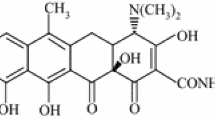Abstract
The interactions of 2-nitroaniline (2-NA), 3-nitroaniline (3-NA) and 4-nitroaniline (4-NA) with bovine serum albumin (BSA) have been investigated by means of fluorescence spectrometry, synchronous fluorescence spectrometry and UV absorption spectrometry under the simulative physiological conditions. Association constants (K A ) were estimated by the remarkable static quenching effect of 2-NA, 3-NA and 4-NA to the intrinsic fluorescence of BSA, and thermodynamic parameters such as enthalpy change (ΔH) and entropy change (ΔS) were calculated according to van’t Hoff equation. The results show that hydrophobic force plays a main role in the interaction of nitroanilines to BSA, nitroanilines have high affinity to BSA and the affinity order is as follows: 4-NA > 2-NA > 3-NA. On the basis of this study, it is found that percents of the binding of nitroanilines to BSA are almost no relative to the concentrations of nitroanilines, and correlation between K A and logK ow is disclosed. In the meantime, relationships between the combination of nitroanilines with BSA and toxicological implications were also discussed. In addition, synchronous fluorescence method was used to study the interaction mechanisms between nitroanilines and BSA, and energy transfer distances from BSA to nitroanilines were estimated based on the Förster’s non-radiation energy transfer theory. The results suggest that the binding site for nitroanilines on BSA is close to the sub-domain IIA where Trp 214 is located.






Similar content being viewed by others
References
Karci F, Sener I, Deligöz H (2003) Azocalixarenes 1: synthesis, characterization and investigation of the absorption spectra of substituted azocalix[4]arenas. Dyes Pigm 59:53–61
Liu YG, Sui Y, Yin J, Gao J, Zhu ZK, Huang DY, Wang ZG (2000) Synthesis and characterization of side-chain polyimides for second-order nonlinear optics via a post-azo-coupling reaction. J Appl Polym Sci 76:290–295
Shen KH, Choi DH, Li ZS (2003) Synthesis, characterization and properties of ethoxylated azo dyes. Fiber Polym 4:32–37
Kulkarni BS, Acharya VN, Khanna RM, Nath S, Mankodi RP, Raghavan P (1969) Methemoglobinemia due to nitro-aniline intoxication: review of the literature with a report of 9 cases. Postgrad Med J 14:192–200
Silva D, Cortez CM, Cunha-Bastos J, Louro SRW (2004) Methyl parathion interaction with human and bovine serum albumin. Toxicol Lett 147:53–61
Bertucci C, Domenici E (2002) Reversible and covalent binding of drugs to human serum albumin: methodological approaches and physiological relevance. Curr Med Chem 9:1463–1481
Kragh-Hansen U (1981) Molecular aspects of ligand binding to serum albumin. Pharmacol Rev 33:17–53
Gulden M, Morchel S, Tahan S, Seibert H (2002) Impact of protein binding on the availability and cytotoxic potency of organochlorine pesticides and chlorophenols in vitro. Toxicology 175:201–213
Shyamali SS, Lillian DR, Lawrence L, Esther B (1979) Fluorescence studies of native and modified neurophysins: effects of peptides and pH. Biochemistry 18:1026–1036
Boelens R, Scheek RM, Dijkstra K, Kaptein R (1985) Sequential assignment of imino- and amino-proton resonances in 1H NMR spectra of oligonucleotides by two-dimensional NMR spectroscopy: application to a lac operator fragment. J Magn Reson 62:378–386
Eftink MR, Ghiron CA (1981) Fluorescence quenching studies with proteins. Anal Biochem 144:199–227
Lakowicz JR, Weber G (1973) Quenching of fluorescence by oxygen: a probe for structural fluctuations in micromolecules. Biochemistry 12:4161–4170
Ware WR (1962) Oxygen quenching of fluorescence in solution: an experimental study of the diffusion process. J Phys Chem 66:455–458
Yang MM, Yang P, Zhang LW (1994) Interaction between caffeinic drugs and albumin by fluorescence spectroscopy. Chinese Sci Bull 39:31–35
Abert WC, Gregory WM, Allan GS (1993) The binding interaction of coomassie blue and proteins. Anal Biochem 213:407–413
Ross PD, Subramanian S (1981) Thermodynamics of protein association reactions: forces contributing to stability. Biochemistry 20:3096–3102
Ma CQ, Li KA, Zhao FL, Tong SY (1999) A study on the reaction mechanism between chrome-azurol S and bovine serum albumin. Acta Chim Sinica 57:389–395
Petitpas I, Grüne T, Bhattacharya AA, Curry S (2001) Crystal structures of human serum albumin complexed with monounsaturated and polyunsaturated fatty acids. J Mol Biol 314:955–960
Carter DC, Ho JX (1994) Structure of serum albumin. Adv Protein Chem 45:153–203
Sulkowska A (2002) Interaction of drugs with bovine and human serum albumin. J Mol Struct 614:227–232
Förster T, Sinanoglu O (eds) (1966) Modern quantum chemistry, vol 3. Academic Press, New York, p 93
Yang JH, Zhao WD, Tong CL, Jie NQ, Zhang GL, Gao ZQ (1996) Terbium(III) luminescence probes: determination of energy transfer distance between metal ion and tryptophan in proteins and postulation of their binding sites. Chem J Chinese Univ 17:451–455
Yan CN, Zhang HX, Mei P, Liu Y (2005) Study on binding reaction between flucytosine and bovine serum album. Chinese J Chem 23:1151–1156
Kasai S, Horie T, Mizuma T (1978) Fluorescence energy transfer study of the relationship between the lone tryptophan residues and drug binding sites in human serum albumin. J Pharm Sci 76:387–392
Cyril L, Earl JK, Sperry WM (1961) Biochemists’ handbook. E&FN Spon, London, p 84
Acknowledgement
We are grateful to the National Natural Science Foundation of China (no. 20577039).
Author information
Authors and Affiliations
Corresponding author
Rights and permissions
About this article
Cite this article
Xiang, G., Tong, C. & Lin, H. Nitroaniline Isomers Interaction with Bovine Serum Albumin and Toxicological Implications. J Fluoresc 17, 512–521 (2007). https://doi.org/10.1007/s10895-007-0203-3
Received:
Accepted:
Published:
Issue Date:
DOI: https://doi.org/10.1007/s10895-007-0203-3




